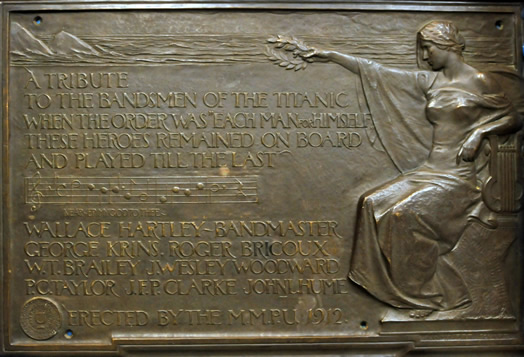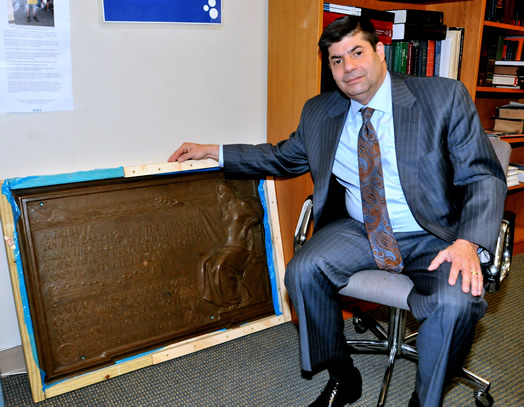Allegro
The Plaque is Back!
A historic relic honoring the brave musicians of the Titanic returns to Local 802
Volume 116, No. 9September, 2016

Harvey Mars, Esq.
Harvey Mars is counsel to Local 802. Legal questions from members are welcome. E-mail them to HsmLaborLaw@HarveyMarsAttorney.com. Harvey Mars’s previous articles in this series are archived at www.HarveyMarsAttorney.com. (Click on “Publications & Articles” from the top menu.) Nothing here or in previous articles should be construed as formal legal advice given in the context of an attorney-client relationship.
What was lost has been found. In 2010, Allegro published an article about a historic plaque commemorating the musicians who died on the Titanic. This plaque used to hang in Local 802’s former headquarters at Roseland Ballroom but was lost when we moved in 1982. Through a fantastic series of events, a law enforcement officer found this plaque (and another that we used to own) in a scrapyard in Florida. This officer, a man named Douglas Turner, read our Allegro article online and learned about the value of the plaques he had recovered. Local 802 attorney Harvey Mars eventually made contact with Mr. Turner and purchased both plaques. Harvey has donated them back to Local 802 and both are now hanging in the Local 802 lobby. You can read our original story here. Below, Harvey tells us the remarkable story of this tribute to the musicians of the Titanic. Photos by Walter Karling.

This plaque, which is hanging at Local 802, says: “A tribute to the bandsmen of the Titanic. When the order was ‘each man for himself,’ these heroes remained on board and played till the last.” The plaque then lists the names of the Titanic musicians: bandleader Wallace Hartley, George Krins, Roger Bricoux, Theodore Brailey, John Wesley Woodward, Percy Cornelius Taylor, John Frederick Preston Clarke and John Law Hume. The plaque was commissioned by Local 802’s predecessor, the Musical Mutual Protective Union, after the Titanic sank on April 15, 1912.
The Titanic was built in 1912 to accommodate 2,500 passengers and 903 officers and crew. It had a heated swimming pool, a squash court, a fully-equipped gymnasium, two libraries, four restaurants, a medical bay, four electric elevators and an operating theater. It is fair to say that the great ship had all the luxuries of an English country home or a gentleman’s club in London. It also had eight of the most accomplished freelance musicians known at the time.
Performing on a ship such as the Titanic was an extremely rigorous task. Just for starters, the band was expected to play both during lunchtime and in restaurants at night. Musicians were also expected to perform for church services and special events. They rehearsed every single day. The shipping line owner, White Star Line, maintained a music book that included 341 numbered pieces that the bandsman were expected to master – and new selections were added constantly. Passengers were given a copy and could request any tune in the book. The band was expected to play it perfectly.
The bandsmen were hired through a contractor, C.W. & F.N. Black. Previously, musicians had been hired directly by the shipping lines. The Black brothers, however, were able to negotiate a deal with the White Star Lines to supply musicians. The Amalgamated Musicians’ Union (the English analog to the AFM at the time) reacted angrily to this arrangement, since the Black brothers were now entitled to a commission that decreased musicians’ earnings by almost 40 percent and eliminated the uniform allowance. (This kind of thing sounds familiar, doesn’t it?)
However, this arrangement meant that musicians were deemed passengers instead of crew. They were no longer under the jurisdiction of the captain. This meant that the Titanic’s bandsmen did not have to remain on the ship while it sank. They could have sought refuge in a lifeboat or attempted to survive in the water. But, as everyone knows, the band heroically chose to remain on board and continued to play.
There is a little controversy over the last selection the musicians played. Some survivors stated that it was a tune called “Autumn.” Others say it was the hymn “Nearer, My God, to Thee.” However, it is uncontroverted that they continued to play on the deck as the ship went down. They played tunes and hymns that evoked peace and calm. As a result Admiral Lord Fisher of England referred to them as “that glorious band.”

Local 802 attorney Harvey Mars with the Titanic Plaque. Mars purchased this plaque (and another) and donated them both to the union.
The story of the bandsmen of the Titanic who kept playing to the very end has captured the imagination of many. Charles A. Haas and John P. Eaton, both of the Titanic International Society, have contributed stories to Allegro about the Titanic musicians. (See “Titanic” article history) Journalist Steven Turner wrote a very detailed account of the Titanic’s bandsman titled “The Band That Played On.” I recommend it highly to anyone interested in exploring why the band continued to play.
While no one will ever know, it is believed that the decision to remain on board and continue to play was made by the Titanic’s bandleader Wallace Hartley. He was an extremely committed and religious man and he had remarked to many of his colleagues that if a ship he played on ever sank, he would remain on board and play “Nearer, My God, to Thee.”
After the musicians perished, several memorials were prepared to honor them. A beautiful monument was erected in the Lancashire town of Colne, England, where Hartley was buried. Another hangs in London’s Royal Albert Hall. In the summer of 1912, a solid bronze plaque was commissioned and forged by the Musical Mutual Protective Union (MMPU), Local 802’s predecessor. It was designed by the German sculptor Albert Weinert and paid for by contributions made by union members. It was unveiled at the union’s headquarters on Nov. 3, 1912.
As readers know by now, the plaque was lost for many years and only recently resurfaced in Florida in 2013. I remember the first time I saw the plaque, I was struck with its beauty. Well, it took quite some effort (and some money) for me to reclaim the plaque and return it to Local 802 where it rightfully belongs. I am very proud to permanently donate it back to the union for all members to enjoy and remember the brave sacrifice of “that glorious band.”
Titanic historians John P. Eaton and Charles A. Haas have prepared an illustrated history of the Titanic entitled “Titanic: Triumph and Tragedy.” On page 296, there is a picture of the MMPU plaque stating that its whereabouts are “presently unknown.” The next edition will state that the plaque’s location is no longer unknown. It’s hanging right here at Local 802 at 322 West 48th Street, New York. The plaque is back.
